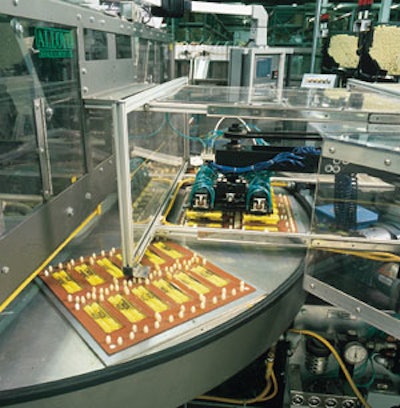
It’s not hard to make a marker—it’s hard to make and package millions of markers in one day,” muses Jim Welch, maintenance manager at Sanford Corp., Bellwood, IL. That train of thought brought about a revolution of sorts at Sanford, a manufacturer of markers, pens and other writing instruments.
Not long ago, high volume at its Bellwood packaging facility, combined with dwindling capacity on the labor-intensive Sharpie® assembly and one-per-blister-card packaging lines, caused Sanford to re-evaluate some of its packaging operations. The 1/card and 2/card Sharpie markers were being produced in one area of the plant. Sanford then either temporarily stored or transported assembled markers to another area of the plant, where as many as six operators were required for packaging, cartoning and case packing.
With the help of Alloyd (DeKalb, IL), Sanford’s longtime supplier for blisters and heat-sealing machinery, the company made its second venture (see sidebar, p. 24) into the “cell” concept of packaging, in which markers are assembled, built and packaged—ready for distribution and sale—at a single location right on the line. Installed in March 1999 with all new machinery, the Sharpie cell paid off for Sanford by providing increased production, convenience, and the ability to redeploy several line workers to other parts of the plant.
Streamlined process
Under Sanford’s old method of packaging the 1/card and 2/card Sharpie and Rubadub® products, one operator ran the machine that assembled the markers. The completed markers were then loaded into a tote for transporting to the next station or for temporary storage. The 1/card packaging line allowed markers to be blister-packed and cartoned automatically, but required three operators. After transporting markers to the heat sealer, one worker would flood the infeed conveyor with markers and make sure they were properly oriented. Another worker supplied the machine with blisters, cards and folding cartons, while a third was required to pack folding cartons into corrugated cases.
On the 2/card packaging line, six workers were necessary: two to orient and place markers into blisters; three to pack blister-carded product into folding cartons; and one to supply the machine with blisters and cards, as well as pack folding cartons into cases. Sanford knew it could do better.
The new programmable logic controller-run Sharpie line requires only two operators, regardless of whether the line is running 1/card or 2/card products. As plant manager T.J. Jordan explains, “One worker operates the assembly machine, runs the infeed conveyor to the blister- carding machine, and monitors the blister-carding machine. A second person supplies the machines with blisters, cards, folding cartons and corrugated cases, as well as monitors the packaging equipment and palletizes the finished cases.”
Using only these two workers, the Sharpie cell has allowed Sanford to reduce the labor content of its 1/card and 2/card formats off of this line by 19% and 54%, respectively. While there has been a slight reduction in throughput from the manual process, it has been more than offset by the reduction in labor content and simplification of the planning process, according to Jordan.
Automation in action
Automatic equipment assembles and collates markers, feeding them onto a laned indexing conveyor from Alloyd. Markers proceed down the conveyor, 12 across. An Alloyd pick-and-place unit with an arm customized for the Sharpie line picks 12 or 24 markers at a time, depending on which card format is running. The day of Packaging World’s visit, the line was running 1/card Sharpie markers, so the pick-and-place at once lifted six markers each from two conveyor rows. The pick-and-place then repeats the iteration to clear the final 12 markers from these two rows.
An Alloyd Model 8SC1616 eight-station automatic heat-seal machine, which accommodates 12 single- or double-pen packs rotates empty blisters arranged in 6x2 formation toward the pick-and-place unit. The pick-and-place arm then loads markers into the blister trays. Once blisters are filled with markers, the heat-seal machine rotates the filled blisters to the next station, where they receive backing cards of 21-pt SBS. The cards are printed offset in four colors on the front and one color on the back, and they are supplied by Dot Packaging (Batavia, IL). At the next station, a heat plate seals the cards to the 10-mil, polyvinyl chloride blisters. Sealed blister packs rotate to the last station, where a 12-head suction device lifts packaged markers from the heat seal machine and drops them face-down into flights in the same 6x2 formation.
The product-filled flights index toward a 90? conveyor. Pneumatic arms advance from the right side and slide the trays to the left, with one moving farther than the other. Blister packs are then pushed out of the trays from behind and transferred into conveyor flights on the collator infeed.
Indexing forward on the conveyor, a group of 12 blister packs enters the collator. From below, alternating blister packs are pushed upward to meet three clamps. Each clamp grabs a pair of products, turning them 90? so that each pair of markers face inward, and the card backs face outward. These three pairs of markers are placed into three slots in front of the conveyor. The left and right slots are pushed to the center so all six marker packs converge. These six packs are then pushed onto one slot on a four-slot wheel that rotates them 270? and deposits them into a flight on another conveyor.
Ready for distribution
Blisters convey in groups of six toward the cartoner. Collating and cartoning equipment is supplied by PMI Cartoning (Elk Grove Village, IL). A rotary arm picks and erects a carton blank before a pusher arm advances six markers into each chipboard folding carton, which is then automatically folded and tucked closed.
The cartons transfer onto another conveyor, where they accumulate before case packing. The Edson (Hamilton, Ontario, Canada) case packer tapes the corrugated cases closed, and the finished cases are then palletized manually and stretch-wrapped.
To further increase efficiency, “improper markers are sensed by photoeyes and rejected off of the assembly machine automatically,” Jordan says. After assembled markers begin the packaging process, says manager of plant engineering, Eric Thoreson, “If a machine senses that a pen is missing or incorrectly aligned, it voids the whole station. That group of markers is pushed off the conveyor into the ‘reject’ bin, from which they will be hand-fed into packs or cartons later. This saves time for the operators and reduces downtime.”
Future plans
Sanford has made a significant investment in the Sharpie cell, which Jordan says was justified by “the needs of expanded production and cost reduction.” He says the cell concept has allowed Sanford to increase labor efficiency, while also simplifying the planning process. “Instead of having to place markers into totes and transport them around the plant before they can be packaged, we can do things start-to-finish [at one location],” he points out. “We’ve been able to expand production and redeploy workers to other areas,” says Jordan, who is proud to point out that Sanford hasn’t had any employee layoffs in 10 years.
The Sharpie line runs two shifts/day, five days a week year-round, and it adds an extra shift/day during the peak months of April through July. “We’re hitting our goal in terms of production right now,” Jordan says. “We’re very pleased with the way the new line is performing.”
So pleased, in fact, that according to Welch, “We’re working with Alloyd, hoping to install a cell or cells that will automatically package three-, four- and five-per-card packages by spring.” Also on tap, Jordan says, are changes to improve changeover times, which currently stand at six hours (see sidebar, right). Through these changes, Sanford hopes to continue the improvements begun with the first Sharpie cell.
























